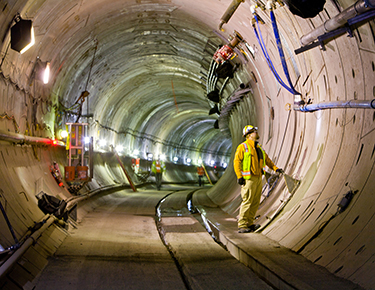|
Subscribe / Renew |
|
|
Contact Us |
|
| ► Subscribe to our Free Weekly Newsletter | |
| home | Welcome, sign in or click here to subscribe. | login |
Architecture & Engineering
| |
 |
January 27, 2014
National finalist: Gold award
Structural systems
HNTB
Project: University Link tunnels under Interstate 5
Client: Sound Transit
One of the most congested bus routes for Sound Transit is from Pine Street in downtown Seattle to the University of Washington — a five-mile journey that takes 30 minutes.
Sound Transit considered all options to improve trip times and reliability, exhausting all surface options until deciding upon underground tunnels. Light-rail tunnels were decided upon to improve commute times from downtown to the university.
HNTB was tasked to design a solution to enable tunnels to be bored without affecting the Interstate 5 retaining walls or roadway surface.
The tunnel option took the shortest route, crossing under I-5, which presented difficulties given the history and makeup of the freeway. I-5 is a 60-year-old, depressed and double-decked freeway flanked by retaining walls.
Preventing movement of the freeway infrastructure was a difficult task considering that the complex and heavily traveled highway is surrounded by a steep, urban landscape. HNTB designed a special geostructural concrete box supported by pilings that would hold up the massive retaining walls while active boring was performed under I-5.
The geostructural boxes were built sequentially, from the top down, utilizing the existing cylinder pile retaining walls and 3-foot-diameter piles on four sides.
The box structure transferred the forces from the existing retaining walls to these new piles that resisted both lateral sliding and rotation. Once the excavation and casting of a structure was complete, the existing wall piles were demolished sequentially from the bottom up, and the boxes were backfilled with controlled density fill.
The tolerance for highway pavement settlement was 1 inch, 0.5 inch for elevated lanes, and 1 inch of deflection at the top of the retaining walls.
HNTB’s geostructure enabled the tunnels to be bored within the tolerances. The pavement moved only 0.25 of an inch, while the retaining wall movement was less than 0.9 inch. An impressive feat considering the tunnel is only 15 feet below I-5.
When the construction equipment was gone, the only signs of the project were fresh pavement, a new coat of sealer on the walls, and a few small survey targets, all of which were planned.
The geostructures allowed the tunnel-boring machine to bore twin tunnels under I-5 without any significant problems — the general public was unaware the boring had occurred.
The University Link light-rail line is expected to convey commuters from downtown Seattle to the University of Washington in six minutes.
In addition, the light rail uses electricity for propulsion, thereby reducing greenhouse gases and reliance on carbon-based fuels. Access to key destinations like the airport, downtown and University District will be improved.
HNTB’s geostructure design successfully addressed the challenges of the project, regarded as one of the highest-risk sections of the project.
Other Stories:
- National finalist: Platinum award
- Best in State: Gold award
Originality/innovation - Best in State: Gold award
Owner/client needs - Best in State: Gold award
Future value to engineering profession - Best in State: Gold award
Complexity - National finalist: Gold award
Environmental - National finalist: Gold award
Energy - National finalist: Gold award
Structural systems - National finalist: Gold award
Special projects - Best in State: Gold award
Social/economic sustainability



